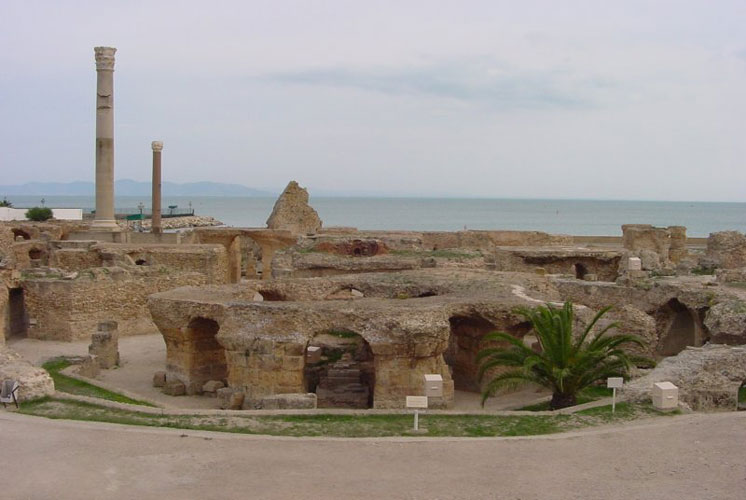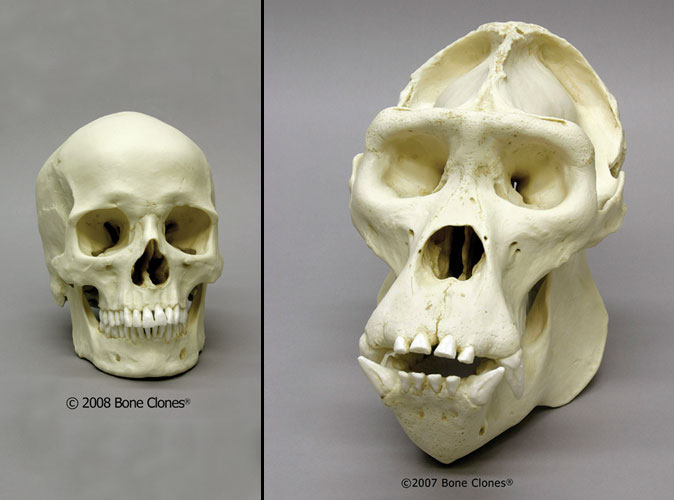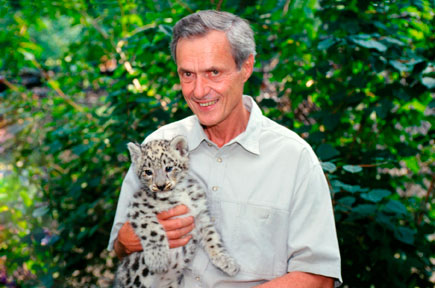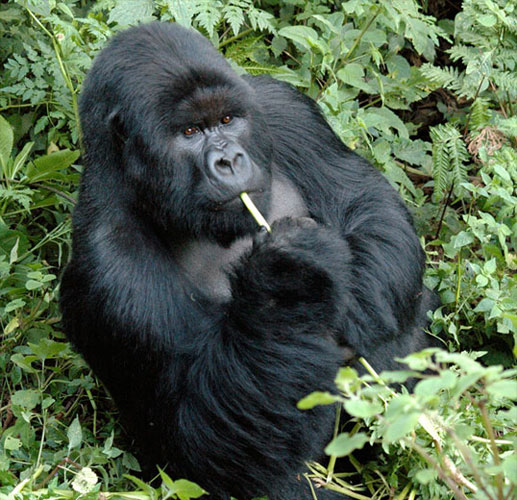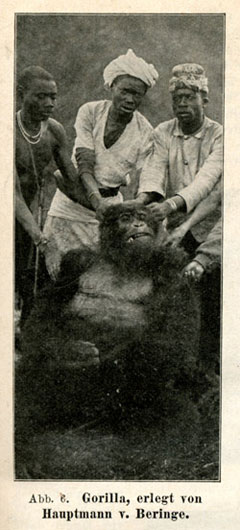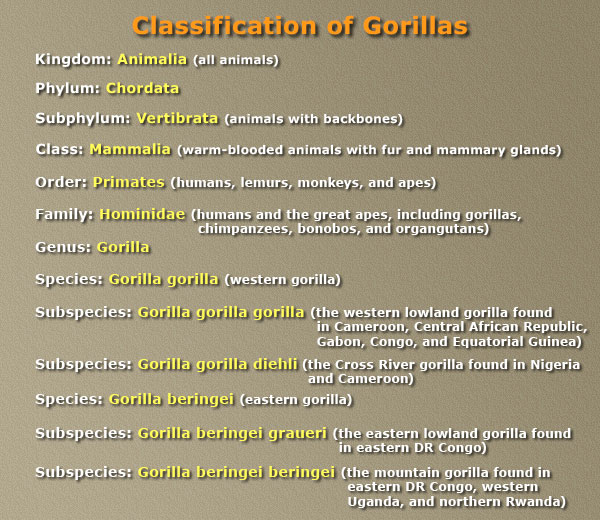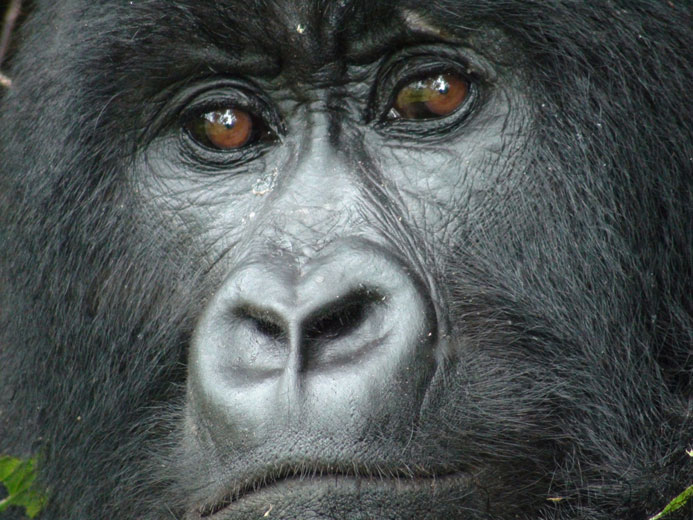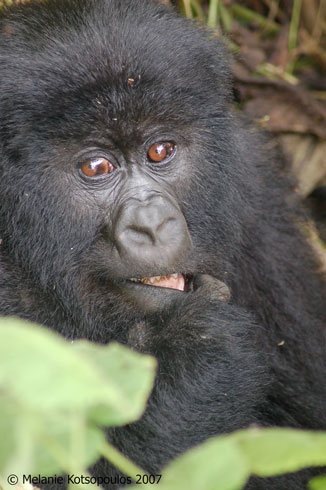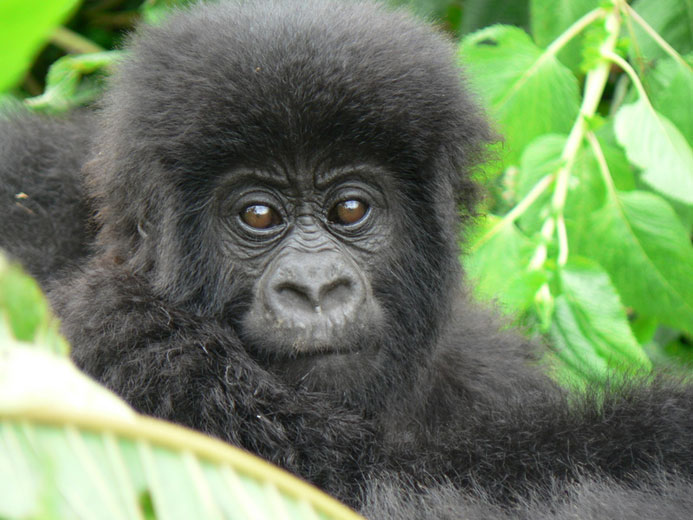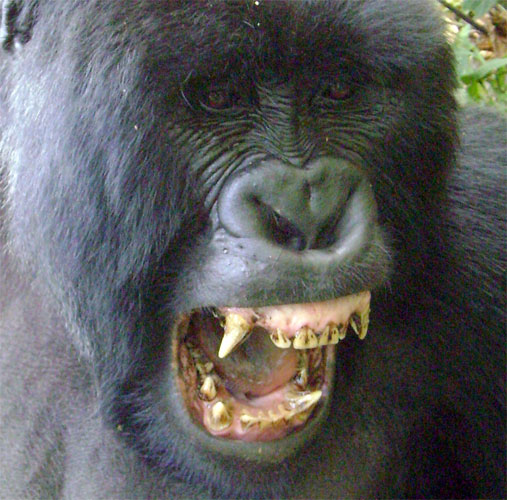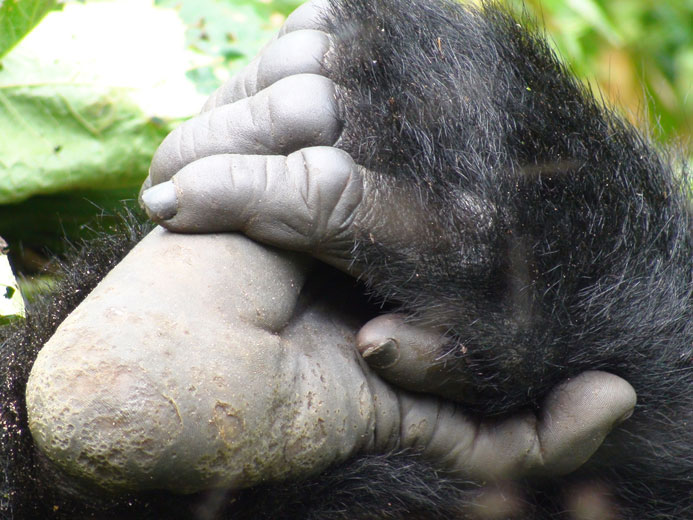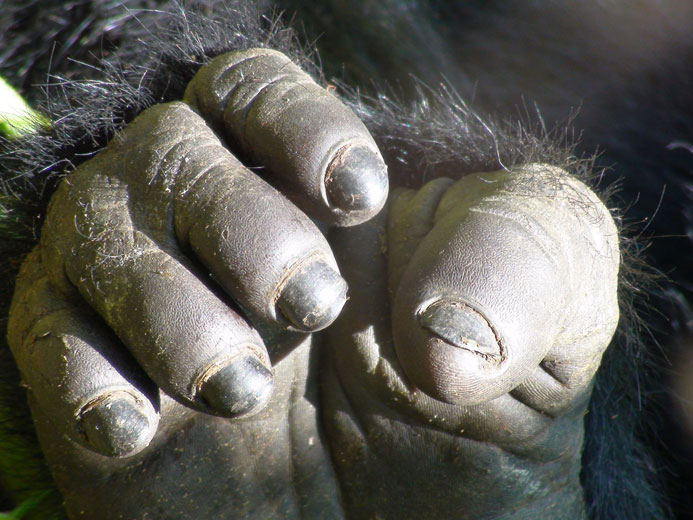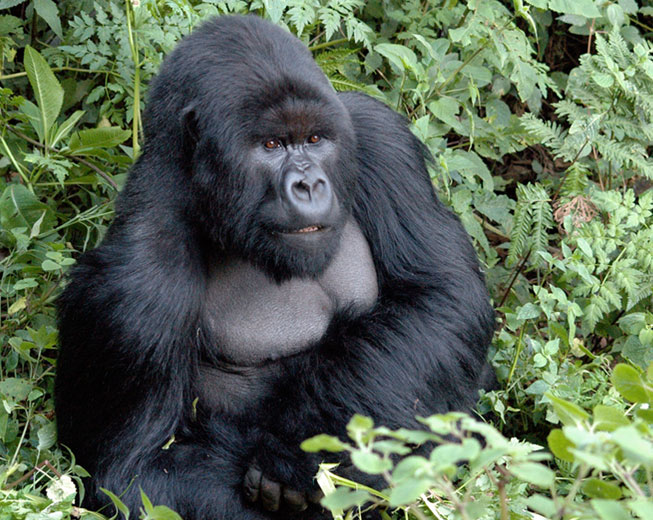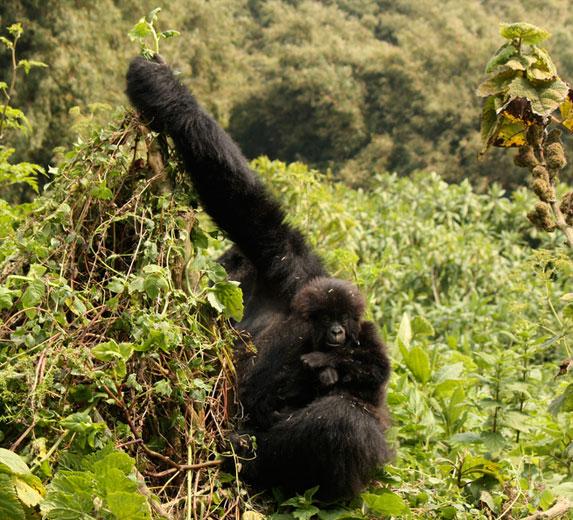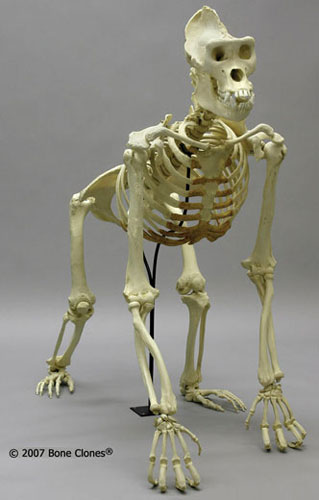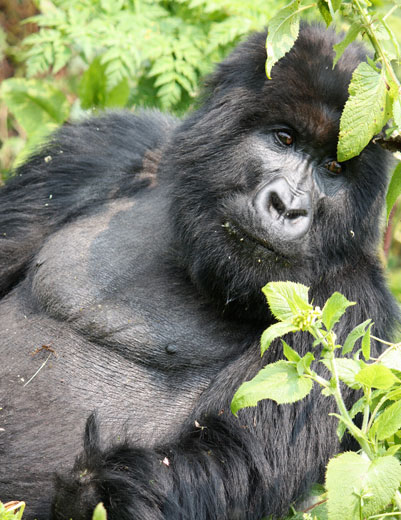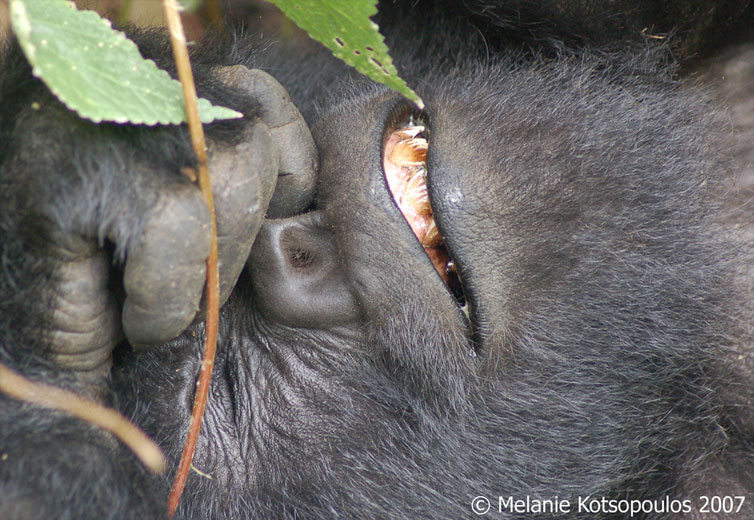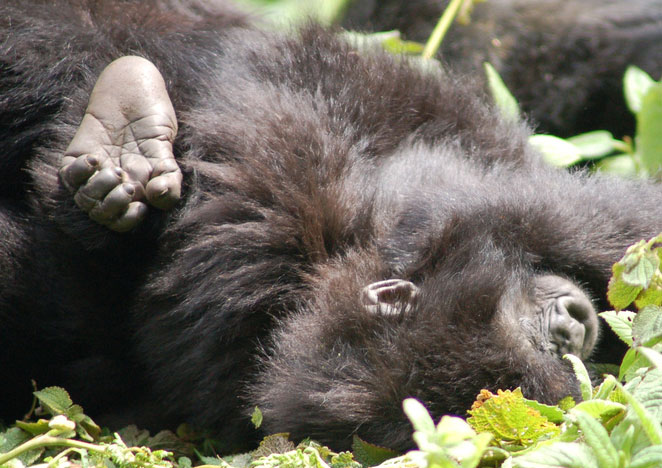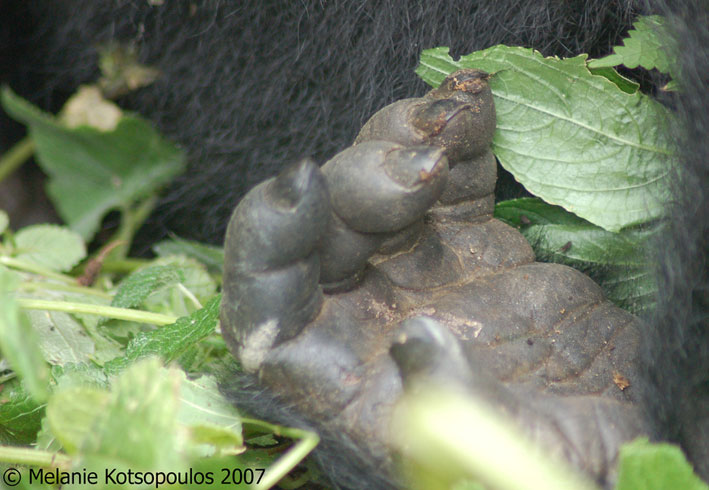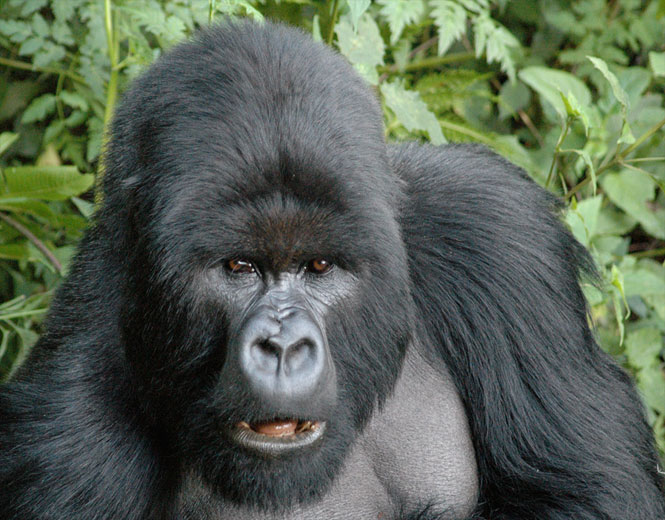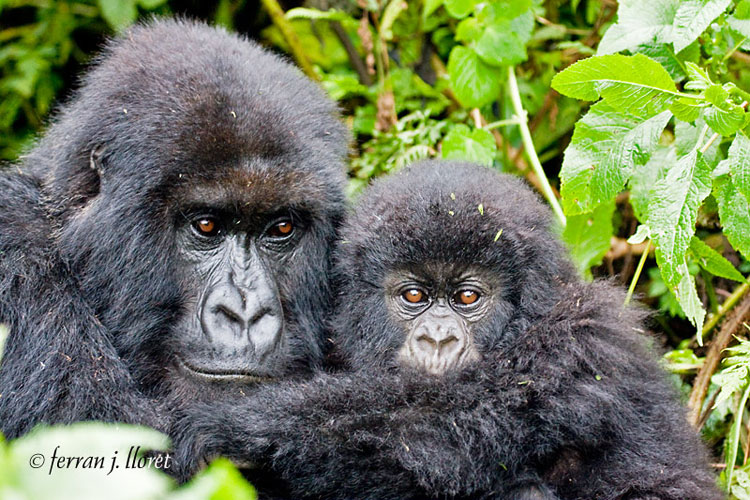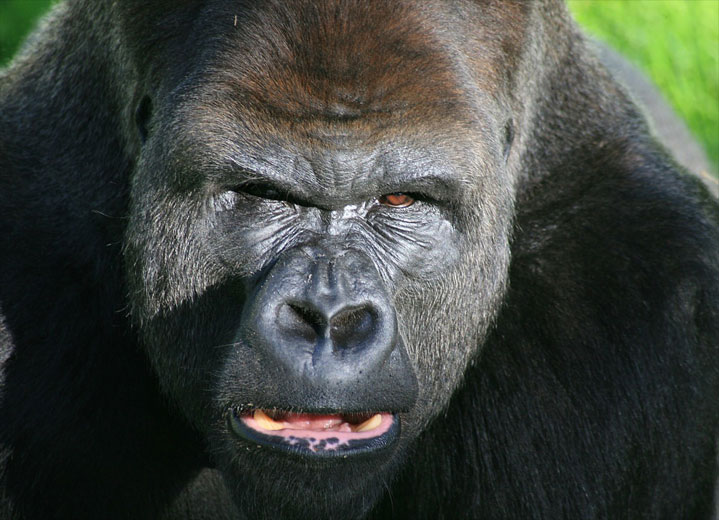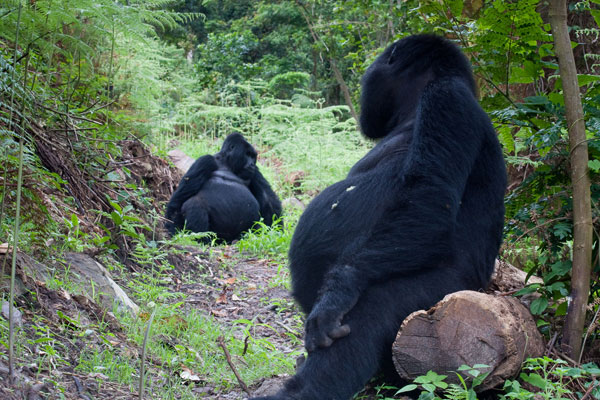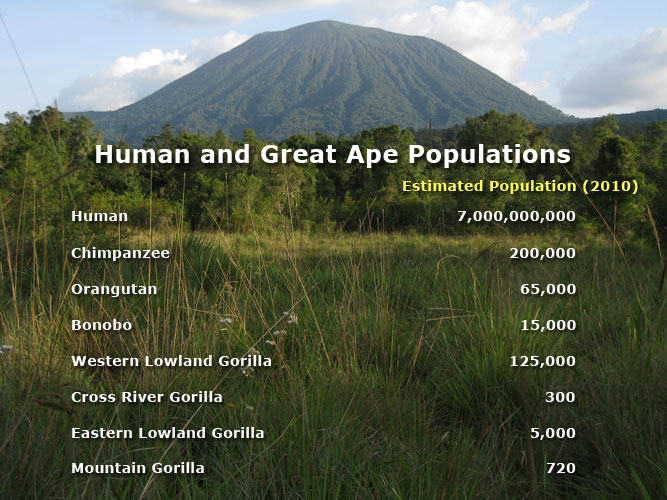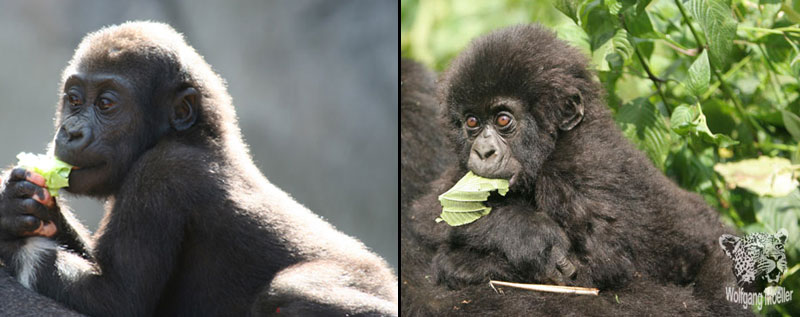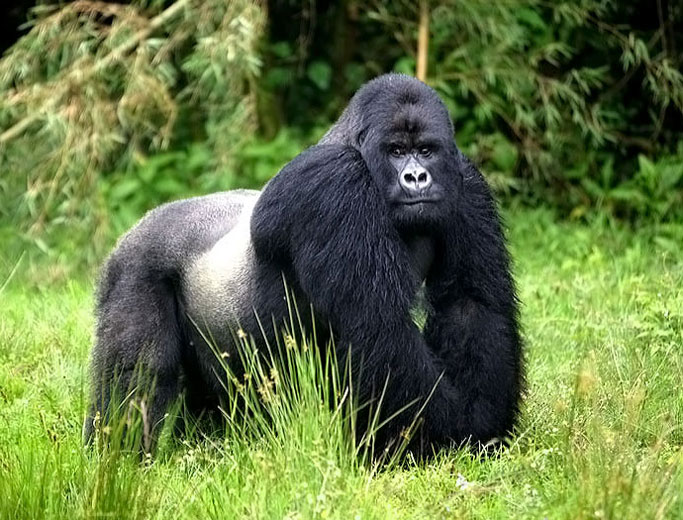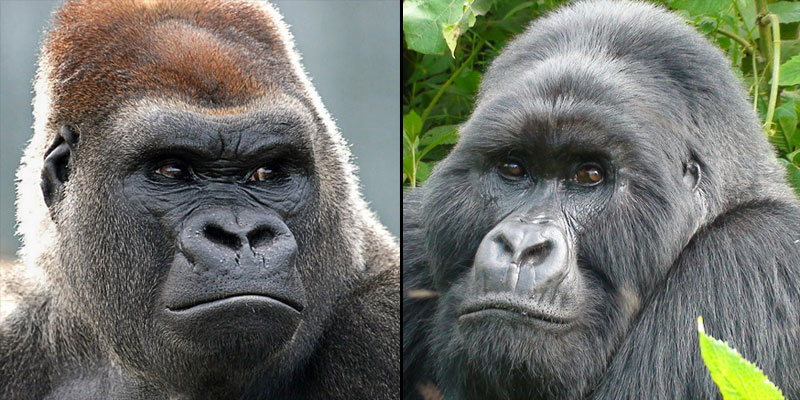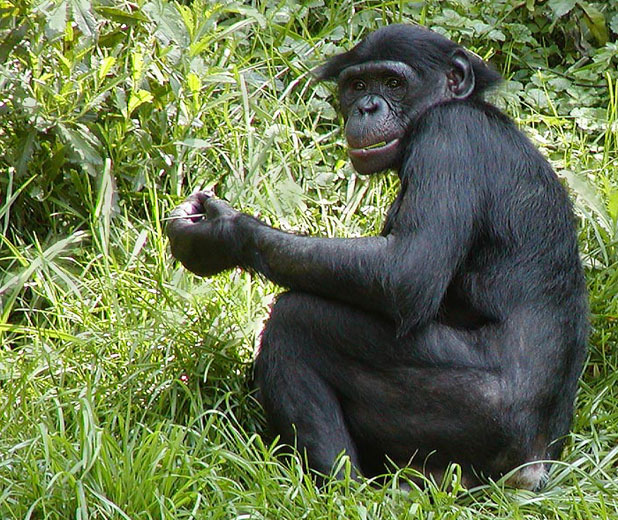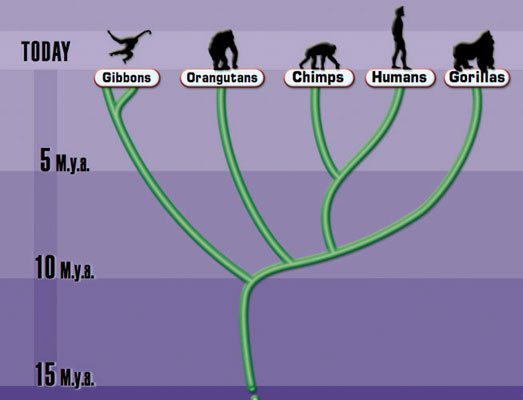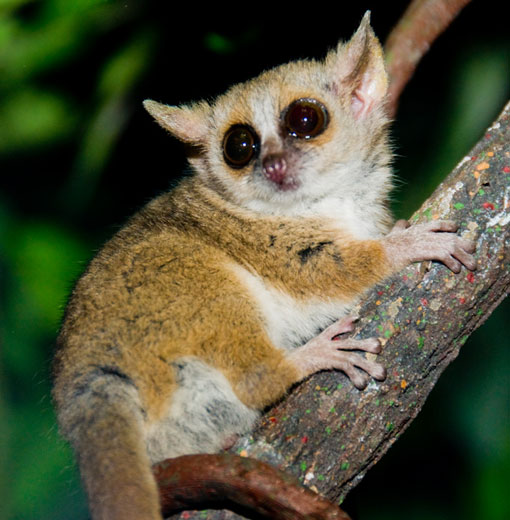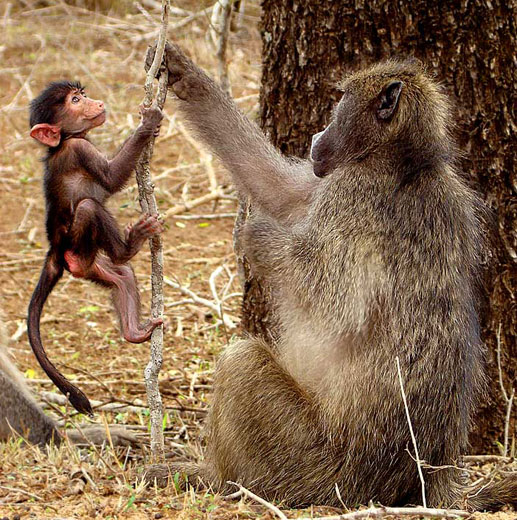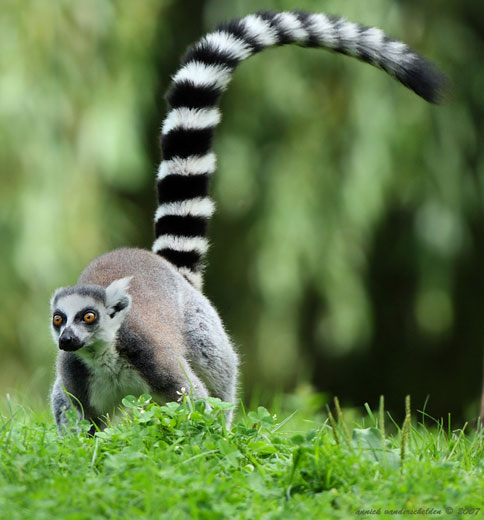|

- Primates
- Population
- Physical Characteristics
- Naming Gorillas
- History with Man
Gorillas belong to a group of mammals called primates, which includes humans. In fact, after chimpanzees, gorillas are our closest living relatives. Primates have bodies that are shaped like humans. Like other mammals, primates are warm blooded,  give birth to live babies, and feed their young with milk produced by mammary glands. Some primates have tails like lemurs and more than 200 species of monkeys. Other primates don’t have tails and are called apes. The great apes include gorillas, chimpanzees, orangutans, baboons, and bonobos. Gibbons are lesser apes. (Gibbons are smaller and less intelligent than the great apes. Whereas great apes can recognize themselves in a mirror, gibbons and monkeys can't. Gibbons are one of the most agile of all animals and can swing from one branch to another that is 9 meters (30 feet) away.) give birth to live babies, and feed their young with milk produced by mammary glands. Some primates have tails like lemurs and more than 200 species of monkeys. Other primates don’t have tails and are called apes. The great apes include gorillas, chimpanzees, orangutans, baboons, and bonobos. Gibbons are lesser apes. (Gibbons are smaller and less intelligent than the great apes. Whereas great apes can recognize themselves in a mirror, gibbons and monkeys can't. Gibbons are one of the most agile of all animals and can swing from one branch to another that is 9 meters (30 feet) away.)
While not all primates actually live in trees, all of them have the ability to climb them. They get around by leaping from tree to tree, walking on two or four limbs, knuckle-walking, and swinging between branches of trees. Which of these forms of locomotion do gorillas use? Although many mammals use smell as their primary sense, primates' ability to smell isn't that well developed, but they compensate that with better vision; they can even see colors. Primates come in all sizes. The mouse lemur is one of the smallest, while the mountain gorilla is the largest.
All gorillas live in forests in Africa, but the mountain gorillas live high in the mountains while the other 3 types live in lower, warmer areas and so are collectively known as lowland gorillas. 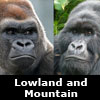 Mountain gorillas are larger than lowland gorillas. Their chests are broader, their hands and feet are wider, and their teeth are longer. Zoos only have lowland gorillas since mountain gorillas can’t breed in captivity. A lot more is known about mountain gorillas than lowland because it is much harder to find and follow animals in flat tropical vegetation than in mountain forests. Also, lowland gorillas have traditionally been hunted for their meat, so they are more afraid of humans, making them harder to approach and study. Both have very close-knit families and put great care into raising their babies. Mountain gorillas are larger than lowland gorillas. Their chests are broader, their hands and feet are wider, and their teeth are longer. Zoos only have lowland gorillas since mountain gorillas can’t breed in captivity. A lot more is known about mountain gorillas than lowland because it is much harder to find and follow animals in flat tropical vegetation than in mountain forests. Also, lowland gorillas have traditionally been hunted for their meat, so they are more afraid of humans, making them harder to approach and study. Both have very close-knit families and put great care into raising their babies.
The population of mountain gorillas living in the wild is now estimated to be about 720. 340 were counted in a 2007 census in Bwindi Impenetrable Forest and 380 were found in a 2007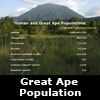 census in the Virunga Mountains. It is impossible to count them exactly because of the thick steep forest. But since they each sleep in their own nest each night (except for the babies), researchers get a fairly accurate idea by counting the number of nests left by each group every morning. census in the Virunga Mountains. It is impossible to count them exactly because of the thick steep forest. But since they each sleep in their own nest each night (except for the babies), researchers get a fairly accurate idea by counting the number of nests left by each group every morning.
Mountain gorillas have pear shaped bodies thanks to their enormous bellies. They have hair all over their bodies except for their face, chest, the palms and fingers of their hands, and the soles of their feet. They have a very large head with a protruding brow and a crest on top. With their tiny ears and small, dark-brown eyes, their eyesight and hearing are about the same as humans. But their 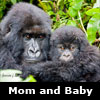 sense of smell is more sensitive than people. Gorillas have black leathery skin and long, thick black hair that insulates it from their cold living conditions at high elevations. sense of smell is more sensitive than people. Gorillas have black leathery skin and long, thick black hair that insulates it from their cold living conditions at high elevations.
Because of the way they move, mountain gorillas have longer, stronger arms than legs; just the opposite of humans. They have a short trunk, a massive chest and broad shoulders. In addition to opposable thumbs like humans, gorillas also have opposable big toes. Prehensile feet allow them to grasp things like branches with all four of their limbs. Their broad hands are extremely strong and have 4 thick fingers and 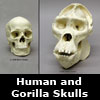 a thumb. a thumb.
Mountain gorillas have a life span of 30 to 40 years. Animals aged 35 years and older frequently suffer from arthritis, especially in their hands and feet. This will slow their movement, requiring more time to forage, feed and travel. However, healthy group members usually slow their pace in deference to these elders. 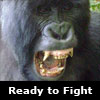
As gorillas age, tartar buildup on their teeth often leads to periodontal disease and gingivitis, eventually resulting in decay and tooth loss. The teeth may be so affected that the dental roots are exposed. It is possible that older animals actually starve to death because they are unable to chew their food.
Legend has it that over 2000 years ago, an explorer named Hanno from the North African city of Carthage encountered apes on the coast of West Africa. He described a wild battle where several of his men were wounded and scratched trying to capture live specimens. The local people called the animal "gorillae", which in their language meant “the scratcher”. When European explorers first discovered gorillas in the 19th century, they assumed that these apes were what Hanno had encountered. While it is now believed the apes he met were probably chimpanzees, the name has remained with gorillas throughout the centuries.
Mountain gorillas’ scientific name is Gorilla beringei beringei. There are 4 kinds of gorillas. There are 2 species: the Western Gorilla and the Eastern Gorilla. It is thought that they diverged from each other about 2 million years ago. Each of these species has 2 subspecies. Some scientists think  that there are actually 5 kinds of gorillas, and list the Bwindi gorilla as a subspecies of the Eastern Gorilla. However, they have only been separated geographically from the mountain gorillas in the Virungas for 500 years, which isn't much time to evolve different physical characteristics. The differences are barely discernable and there remains much disagreement on the distinction between the two. Because of this, they have not yet been given their own scientific name. that there are actually 5 kinds of gorillas, and list the Bwindi gorilla as a subspecies of the Eastern Gorilla. However, they have only been separated geographically from the mountain gorillas in the Virungas for 500 years, which isn't much time to evolve different physical characteristics. The differences are barely discernable and there remains much disagreement on the distinction between the two. Because of this, they have not yet been given their own scientific name.
Gorillas were the last of all the apes to be discovered by westerners. For centuries, explorers would return home with intriguing tales of frightening hairy giants. They would tell people that gorillas were half man, half beasts that were wild and viscious, sometimes tearing a man limb from limb and carrying his woman into the forest. These accounts were exagerated and sensationalized, but made for great stories!
Finally, in 1847, American Thomas Savage found some skeletons with skulls of a creature in Gabon that nobody recognized. It turned out to be the lowland gorilla. What followed for many years was a disturbing trend of killing them for museums and for scientists to study their anatomy. Very little was known about their behavior and so they became incorrectly known for being aggressive and violent.
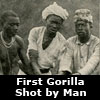 In 1902, German army officer Oscar von Beringe was the first European to see the mountain gorillas in the Virunga Volcanoes of Central Africa. He was also the first to shoot them. He killed two. Mountain gorillas were given the name Gorilla beringei beringei in honor of him. In 1902, German army officer Oscar von Beringe was the first European to see the mountain gorillas in the Virunga Volcanoes of Central Africa. He was also the first to shoot them. He killed two. Mountain gorillas were given the name Gorilla beringei beringei in honor of him.
Then in 1921, American hunter Carl Akeley went to the Virungas to shoot gorillas for the Museum of Natural History in New York. Because of his profound connection with the animals he came to kill, he persuaded the Belgian government, which then controlled the Virungas, to create a park to protect the gorillas. This area became Albert National Park in 1926, the first national park on the whole continent of Africa.
More than 30 years later, George Schaller became the first scientist to study mountain gorillas in the wild. George Schaller not only pioneered research on gorillas, but tigers, lions, snow leopards, and pandas as well. 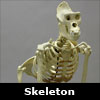 But it is his work with the mountain gorillas in 1959-60 that he is most famous for. He spent 20 months following, studying, and habituating them. But it is his work with the mountain gorillas in 1959-60 that he is most famous for. He spent 20 months following, studying, and habituating them.
After reading Schaller’s research, Dian Fossey became obsessed with learning more and so she began her own intensive study in 1967. Fossey became aware of the fact that there were two main threats to the gorillas- poachers and cattle grazing in the park. The guards she hired destroyed the snares, chased the cattle away, and burned the poachers’ camps to the ground.
Fossey saw two gorillas die when their injuries from snares got infected. She saw another die from an infection of a bullet wound from a poacher. Two more died from hookworms, an intestinal parasite found in humans as well. This led her to suspect that perhaps tourists and park rangers were passing on their  diseases to the gorillas. She knew that with so few gorillas in existence, it was crucial for every single one to be helped as much as possible in order to prevent their extinction as a species. This prompted her to ask the Morris Animal Foundation if they could create a program that had veterinarians to treat gorillas that were harmed by humans. diseases to the gorillas. She knew that with so few gorillas in existence, it was crucial for every single one to be helped as much as possible in order to prevent their extinction as a species. This prompted her to ask the Morris Animal Foundation if they could create a program that had veterinarians to treat gorillas that were harmed by humans.
Unfortunately, Dian Fossey was murdered at her research station at Karisoke in 1985. The murder was never solved, but she had created many enemies who didn’t appreciate her placing more importance on the gorillas than on the local people. She was buried among the 17 gorillas that had been killed by poachers during her research. Soon after her death, the Morris Animal Foundation funded the Mountain Gorilla Veterinary Project (The Gorilla Doctors).
|
|
|
n. Doctors who treat diseased or injured animals.
v. To make something used to or accustomed to
something else. Mountain gorillas have been
habituated to humans so that they are not afraid of us.
The branch of science concerned with the study of the bodies
of humans, animals, and other organisms, especially through
the dissection and separation of the bodily parts.
A Protestant clergyman, physician, and naturalist,
he was sent to Liberia as a missionary in 1836.
adj. Perceptable; recognizable
v. To separate from or go in a different direction.
Also known as Hanno the Navigator, he was a Carthaginian
explorer around 500 BC. He commanded a fleet of 60 ships
on his now famous voyage to West Africa.
n. Inflammation of the gums.
adj. Relating to the branch of dentistry
concerned
with the gums and jaw bones.
n. A hard yellowish deposit on the
teeth
that contributes to tooth decay.
n. Humble submission and respect.
n. Painful inflammation and stiffness of the joints.
n. A person's or animal's body
apart from the limbs and head.
n. The length of time for which a person
or animal lives or a thing functions.
The western lowland, eastern lowland,
and the cross river gorillas.
n. The act of moving from place to place.
Knuckle walking. Using both their arms and legs,
they put their weight on their knuckles as they
move around the forest.
n. A mammal of the order Primates, which includes
characteristics such as well-developed hands and
feet, a short snout, and a large brain.

